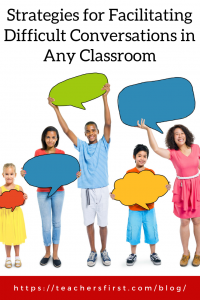“My father used to say, ‘Don’t raise your voice; improve your argument.’”
Desmond Tutu
Each August, the United Nations celebrates the accomplishments and potential of youth worldwide with International Youth Day. This day celebrates young people’s contributions to conflict prevention and transformation, as well as inclusion, social justice, and sustainable peace.
International Youth Day’s goals are certainly lofty ones. Conflict prevention and transformation aren’t always natural skills, but they can be taught in any classroom, beginning with our youngest students.
Many educators struggle with how to handle difficult conversations, and it’s essential to have strategies available that allow students to engage in respectful discussions while allowing for differences of ideas and opinions. Proper preparation by both students and the teacher provides all class members the opportunity to be included and share their ideas in a safe environment.
As students become comfortable participating in respectful conversations, they take these skills beyond the classroom for use in their everyday lives. These critical skills are also beneficial as students mature and deal with adults in the workforce.
This TeachersFirst Twitter chat shares ideas and resources to help you facilitate difficult conversations in the classroom. Participants discussed the importance of recognizing different perspectives found within classrooms, shared strategies for practicing and improving communications skills, and explored approaches to enhancing critical thinking skills. Browse the chat archive to find many specific examples of difficult conversations that happen in classrooms and advice from other educators on how to facilitate conversations that support all students with respect.
Using a particular strategy for classroom conversations is another way to prepare students for difficult discussions and promote critical thinking skills. Academic Conversations incorporates five essential skills that thoughtfully guide discussions:
- Elaborate and Clarify.
- Support Ideas with Examples.
- Building on or Challenging Partner’s Ideas.
- Paraphrasing.
- Synthesizing Conversations Points.
For more specific, step-by-step activities for teaching students how to debate challenging topics, look at ProCon (reviewed here). ProCon’s mission is to provide non-biased information for its users. The format provides an overview of debated topics, then side-by-side pro and con arguments for the question. Following the pro and con section is a series of additional discussion questions, ideas for taking action, and credits for resources used. Recent topics include the pros and cons of Washington, D.C. and Puerto Rico statehood, standardized tests, and bottled water bans.
Although ProCon topics are suitable for middle school and older students, the format is adaptable to any classroom. Consider using examples from ProCon in your classroom as a guide for teaching students how to debate politely by using the information to support both sides of the question.
Let’s use ProCon as a guide for starting a classroom debate with some suggested first topics:
- Elementary – Which pet is best—cats or dogs? What time should school start? Should kids stay up as late as they want?
- Upper Elementary to Middle School – Do video games teach bad habits? Should schools require nightly homework? Should zoos be illegal?
- High School – Should athletic teams allow both boys and girls on the same team? Should colleges require minimum ACT or SAT scores for admission? Should community college be free?
After choosing a topic, decide on a tool to share resources and provide information about both sides of the conversation. Here are some of our favorites:
- The simplest way to recreate the pro/con format found on ProCon is by using a whiteboard tool such as Jamboard (reviewed here). Start with a column for each point of view and ask students to share a sticky note in their chosen column. Consider creating an image to use as a background for use as a template—adding your template as a background makes it easier for students to add information while keeping your columns and text intact.
- Create flyers, images, presentations, and more that engage and interest viewers with the simple-to-use tools in Canva (reviewed here). For younger students, choose the option to create a card, then add an image to represent both sides of the question and add text that supports each side. When finished, download your card and print it to display in your classroom or upload it to a form to extend student learning. Older students can create presentations that support their side of the debate. Combine and share their finished products to create a class presentation.
- Adobe Spark (reviewed here) is another tool for creating and sharing student presentations. Start with a blank page or use the free templates to create web pages, presentations, and videos that share information about your topic of discussion. Download your finished presentations or use links to include them within a larger project.
- Find and use free images to bring any presentation to life. Unsplash for Education (reviewed here), Fresh Folk (reviewed here), and Nappy (reviewed here) are a few excellent free image sites that offer a variety of images for classroom use. Of course, always keep in mind proper attribution when using images!
- Once your class or students create their pro/con presentations, consider including them all in a more extensive presentation. Sway (reviewed here) and Book Creator (reviewed here) are excellent options for creating and sharing images, audio recordings, and video class presentations.
Thoughtful preparation and teaching strategies provide the tools you need to facilitate difficult conversations in the classroom. Use these ideas to teach students how to have respectful debates while promoting critical thinking skills by including fact-based discussions. As students become familiar with how to debate respectfully, they obtain invaluable skills they’ll use throughout their school years and beyond.
What do you do to promote respectful conversations in your classroom? Have you had problems with difficult conversations? We always enjoy hearing your ideas and experiences in the comments below.


